Beth Tabler's Blog, page 190
May 13, 2022
Indie Military Science Fiction and Space Opera books – Part 1
Space opera and military science fiction are genres that have benefited tremendously from the boom in indie publishing. If nothing else, geeks love space and thus the kind of people who own kindles and other e-readers are inclined to check out this pair of genres. However, there’s a massive amount of books that can be intimidating for readers to sort through. This is in addition to all the wonderfully traditionally published books that can be found on Barnes and Noble or Amazon’s websites.
Rather than take on the daunting task of recommending twenty science fiction novels in space that are published by someone other than the “Big Six” publishers, my friend Steve Caldwell and I have decided to combine our respective love of the genre to talk about stories that you can’t go wrong with. Yes, some of these books have some rough edges but others are just plain fantastic. All of them are worth giving a read. I should know, I’ve written my own in Lucifer’s Star and Space Academy Dropouts.
Here is part 1.
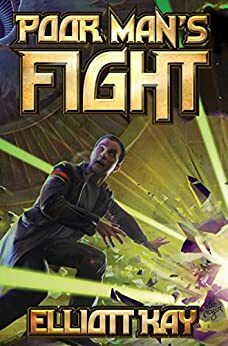 Poor Man’s Fight is the story of student debt combined with Starship Troopers. A young man fails to get into the college of his choice and decides he’s going to end up enlisting in hopes of escaping his financial situation: a very common story in the real world. The difference is that it is in space and rapidly becomes Die Hard with a luxury liner. I very much enjoyed this military sci-fi coming-of-age drama and while it’s not the most original story, I read the rest of the series immediately thereafter.
Poor Man’s Fight is the story of student debt combined with Starship Troopers. A young man fails to get into the college of his choice and decides he’s going to end up enlisting in hopes of escaping his financial situation: a very common story in the real world. The difference is that it is in space and rapidly becomes Die Hard with a luxury liner. I very much enjoyed this military sci-fi coming-of-age drama and while it’s not the most original story, I read the rest of the series immediately thereafter.
“This test completes your compulsory education. Congratulations! You have graduated high school. Your financial obligation is 67,879 credits. Please visit our loan officer as you exit.”
Tanner Malone never bought into military myths of honor and glory. He never wanted to wear a uniform or medals. Yet when family upheaval brings his otherwise stellar performance in school to a disastrous end, Tanner’s plans for university lie in ruins. Facing homelessness and a mountain of debt, Tanner enlists in his home planet’s tiny navy.
It’s a hell of a time to sign up. Vicious pirates stalk the space lanes, claiming to fight an oppressive economic system even as they shed innocent blood. Civil war looms beyond the borders of Tanner’s home star system of Archangel. Corporate security fleets are nowhere to be found when trouble arises.
In response, Archangel begins ambitious military expansion. Basic training becomes six months of daily bare knuckle brawls, demanding cross-training and constant stress. Brutal as it is, Tanner will need the preparation. The pirates grow more audacious with every attack. As if that’s not enough, Tanner is assigned to a small ship whose disgruntled crew has no patience for cerebral new recruits, and they’re on the front lines of all of Archangel’s woes.
Tanner soon learns there is only one way to deal with his bullying comrades, their ruthless foes and the unforgiving void of space, and that’s to get up close and personal.
Starship’s Mage by Glynn Stewart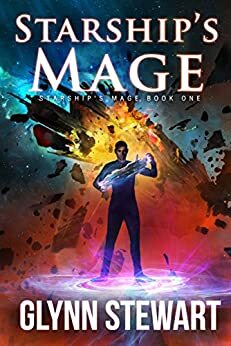 Glynn Stewart is a master of writing science fiction and space opera. However, of all of his series, my favorite has to be Starship’s Mage. In the future, magic has been unlocked via alien genetic engineering and is the sole way to to travel faster than light. Our protagonist just wants to get a job hauling freight but events make him an outlaw. However, it’s actually the beginning of a massive destiny that is an easily-readable epic.
Glynn Stewart is a master of writing science fiction and space opera. However, of all of his series, my favorite has to be Starship’s Mage. In the future, magic has been unlocked via alien genetic engineering and is the sole way to to travel faster than light. Our protagonist just wants to get a job hauling freight but events make him an outlaw. However, it’s actually the beginning of a massive destiny that is an easily-readable epic.
In a galaxy tied together by the magic of the elite Jump Magi, Damien Montgomery is a newly graduated member of their number.
With no family or connections to find a ship, he is forced to service on an interstellar freighter known to be hunted by pirates.
When he takes drastic action to save the “Blue Jay” from their pursuers, he sets in motion a sequence of events beyond his control – and attracts enemies on both sides of the law!
Starship’s Mage was originally released as five separate episodes.
Star Quest: The Journey Begins by Patricia Lee Macomber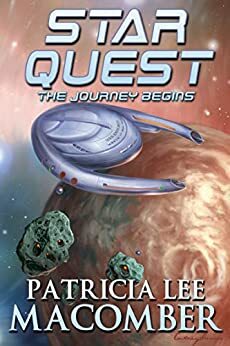 Patricia Macomber’s Star Quest novels are on the much lighter side of reading. Humanity has already won a war against an alien invasion and now they’ve decided to use their reverse-engineered alien technology to explore the galaxy. It’s a shameless Star Trek homage and I loved every minute of it, especially as humanity doesn’t have any idea what sort of rules there should be for space travel.
Patricia Macomber’s Star Quest novels are on the much lighter side of reading. Humanity has already won a war against an alien invasion and now they’ve decided to use their reverse-engineered alien technology to explore the galaxy. It’s a shameless Star Trek homage and I loved every minute of it, especially as humanity doesn’t have any idea what sort of rules there should be for space travel.
Cara Bishop already saved the world. Now, with the war over and the aliens defeated, she’s teaching other pilots to fly the alien ships that turned the tide. Until the government approaches her about joining a super secret mission, that is.
Steve Hunter is the product of alien DNA. He was created in a lab, designed to destroy the aliens in a ground war that was never fought. Now, they’re finally putting him to use as the leader of this new mission.
Together with the scientist who created Steve and the genius who invented the ship, Cara and her captain set off on a final adventure. The U.S.S. Endeavor goes in search of allies among the stars. What they find is more than they ever bargained for. If their mission is to be a success, they will have to solve a mystery and escape destruction at the hands of an all new foe. All in a day’s work for the Endeavor crew.
Expeditionary Force: Columbus Day by Craig Alanson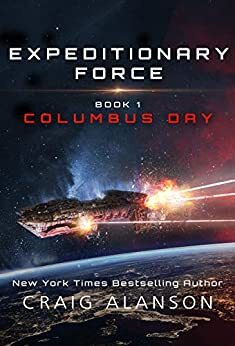 Expeditionary Force is a interesting story of self-publishing success as it went from a mild success to something that is approaching a phenomenon thanks to the narration of R.C. Bray. While I strongly recommend the audiobook version of this series over the written, I still enjoyed it both ways. It’s the story of humanity getting into space as part of an alien visitor’s forces, only to find out our patrons are scumbags and we’re hopelessly outmatched by everyone. However, a chance encounter gives one schlub a super-advanced AI that changes everything.
Expeditionary Force is a interesting story of self-publishing success as it went from a mild success to something that is approaching a phenomenon thanks to the narration of R.C. Bray. While I strongly recommend the audiobook version of this series over the written, I still enjoyed it both ways. It’s the story of humanity getting into space as part of an alien visitor’s forces, only to find out our patrons are scumbags and we’re hopelessly outmatched by everyone. However, a chance encounter gives one schlub a super-advanced AI that changes everything.
We were fighting on the wrong side, of a war we couldn’t win. And that was the good news.
The Ruhar hit us on Columbus Day. There we were, innocently drifting along the cosmos on our little blue marble, like the native Americans in 1492. Over the horizon come ships of a technologically advanced, aggressive culture, and BAM! There go the good old days, when humans only got killed by each other. So, Columbus Day. It fits.
When the morning sky twinkled again, this time with Kristang starships jumping in to hammer the Ruhar, we thought we were saved. The UN Expeditionary Force hitched a ride on Kristang ships to fight the Ruhar, wherever our new allies thought we could be useful. So, I went from fighting with the US Army in Nigeria, to fighting in space. It was lies, all of it. We shouldn’t even be fighting the Ruhar, they aren’t our enemy, our allies are.
I’d better start at the beginning…
Hard Luck Hank: Screw the Galaxy by Steven Campbell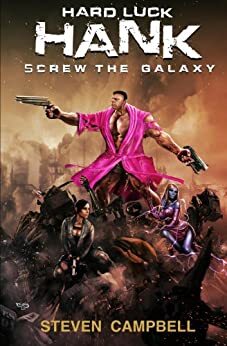 Contrary to the other stories in this list, Hard Luck Hank is a space opera story about someone who is not a galactic hero or a military commander. Indeed, Hank is a real piece of garbage that serves as a petty leg breaker on a space station in the vast Colmarrian Federation. He’s a great character with a Patrick Warburton-esque vibe even when he’s not having his narrator speak like him. I really enjoyed this book series and while it drags in places, the first novel is note perfect.
Contrary to the other stories in this list, Hard Luck Hank is a space opera story about someone who is not a galactic hero or a military commander. Indeed, Hank is a real piece of garbage that serves as a petty leg breaker on a space station in the vast Colmarrian Federation. He’s a great character with a Patrick Warburton-esque vibe even when he’s not having his narrator speak like him. I really enjoyed this book series and while it drags in places, the first novel is note perfect.
Hank is a thug. He knows he’s a thug. He has no problem with that realization. In his view the galaxy has given him a gift: a mutation that allows him to withstand great deals of physical trauma. He puts his abilities to the best use possible and that isn’t by being a scientist.
Besides, the space station Belvaille doesn’t need scientists. It is not, generally, a thinking person’s locale. It is the remotest habitation in the entire Colmarian Confederation. There is literally no reason to be there.
Unless you are a criminal.
Because of its location, Belvaille is populated with nothing but crooks. Every day is a series of power struggles between the crime bosses.
Hank is an intrinsic part of this community as a premier gang negotiator. Not because he is eloquent or brilliant or an expert combatant, but because if you shoot him in the face he keeps on talking.
Hank believes he has it pretty good until a beautiful and mysterious blue woman enters his life with a compelling job offer.
Hank and Belvaille, so long out of public scrutiny, suddenly find themselves at the epicenter of the galaxy with a lot of very unwelcome attention.
Into the Dark (Alexis Carew #1) by JA Sutherland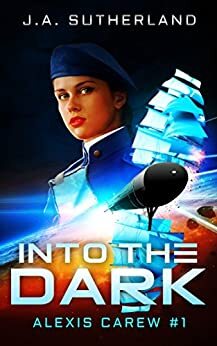 Steampunk is something that is normally not associated with space opera. However, Into the Dark is a delightful Honor Harrington-esque story of a young woman joining a starship crew to escape a sexist society on her home colony. The Navy proves to be even worse in some respects but few people are as capable or determined as Alexis Carew in her desire to prove themselves. Sails, rum, and the lash are part of Her Majesty’s Navy but so are darkspace shoals as well as space pirates. Fun for the whole family!
Steampunk is something that is normally not associated with space opera. However, Into the Dark is a delightful Honor Harrington-esque story of a young woman joining a starship crew to escape a sexist society on her home colony. The Navy proves to be even worse in some respects but few people are as capable or determined as Alexis Carew in her desire to prove themselves. Sails, rum, and the lash are part of Her Majesty’s Navy but so are darkspace shoals as well as space pirates. Fun for the whole family!
At 15, Alexis Carew has to face an age-old problem – she’s a girl, and only a boy can inherit the family’s vast holdings. Her options are few. She must marry and watch a stranger run the lands, or become a penniless tenant and see the lands she so dearly loves sold off. Yet there may be another option, one that involves becoming a midshipman on a shorthanded spaceship with no other females.
The Skald’s Black Verse (The Dreadbound Ode #1) by Jordan Loyal Short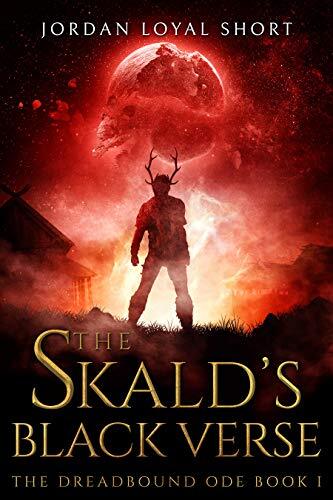 https://www.amazon.com/Skalds-Black-Verse-Dreadbound-Book-ebook/dp/B07K826497
Warhammer 40K is its own unique brand of storytelling, combining dark fantasy with post-apocalypse space opera. The Skald’s Black Verse is set on a distant planet that has degenerated to Viking-like barbarism and occupied by a brutal intergalatic empire that is, itself, barely hovering above Medieval ethics. It’s dark, gritty, and full of both magic as well as twisted gods. Michael Moorcock and Black Library would be proud.
https://www.amazon.com/Skalds-Black-Verse-Dreadbound-Book-ebook/dp/B07K826497
Warhammer 40K is its own unique brand of storytelling, combining dark fantasy with post-apocalypse space opera. The Skald’s Black Verse is set on a distant planet that has degenerated to Viking-like barbarism and occupied by a brutal intergalatic empire that is, itself, barely hovering above Medieval ethics. It’s dark, gritty, and full of both magic as well as twisted gods. Michael Moorcock and Black Library would be proud.
Brohr has been lied to, abused.
All he wants is to live in peace, away from the ignorance of his village, to outrun the raging ghost which haunts him.
But a hidden evil seeks to harness Brohr’s fury.
Accused of murder, hunted by ruthless soldiers, Brohr delves the way of the Skald, unlocking forbidden blood magic as he unearths terrible family secrets.
When the red moon is broken, and all is lost, it’s up to Brohr to lead a rebellion, or face the end of the world.
Starship for Sale by M.R. Forbes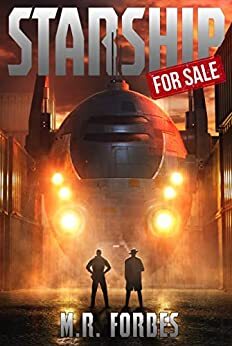 I was a big fan of The Last Starfighter movie that is one of my guilty-pleasures. Basically, a young man’s skill at video games results in him getting recruited into a cosmic space force. Except, this time it’s a con man and he’s actually trying to bilk his friend out of an inheritance. The starship is real, though, and so are all the troubles when our teenage heroes get themselves sent into space. I really enjoyed this book and it is my favorite of M.R. Forbes’ works.
I was a big fan of The Last Starfighter movie that is one of my guilty-pleasures. Basically, a young man’s skill at video games results in him getting recruited into a cosmic space force. Except, this time it’s a con man and he’s actually trying to bilk his friend out of an inheritance. The starship is real, though, and so are all the troubles when our teenage heroes get themselves sent into space. I really enjoyed this book and it is my favorite of M.R. Forbes’ works.
When Ben Murdock receives a text message offering a fully operational starship for sale, he’s certain it has to be a joke.
Already trapped in the worst day of his life and desperate for a way out, he decides to play along. Except there is no joke. The starship is real. And Ben’s life is going to change in ways he never dreamed possible.
All he has to do is sign the contract.
Joined by his streetwise best friend and a bizarre tenant with an unseverable lease, he’ll soon discover that the universe is more volatile, treacherous, and awesome than he ever imagined.
And the only thing harder than owning a starship is staying alive.
If you like found starships, unlikely heroes and intergalactic mayhem, you’ll love Starship For Sale, the latest sci-fi adventure from bestselling author M.R. Forbes.
Backyard Starship by JN Chaney, Terry Maggert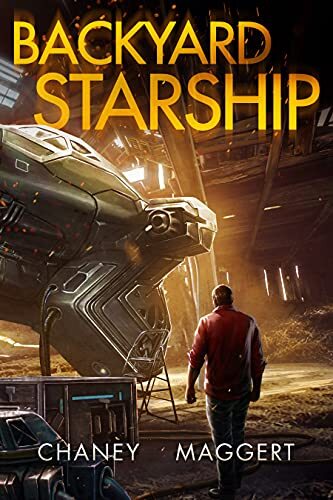 A somewhat similar book to Starship for Sale, Val Tudor inherits his grandfather’s starship as well as all of his debts. I really enjoy this kind of “fish out of water” stories and seeing an adult man get the chance to explore the universe after a life on Plain Ol’ Earth is an interesting twist on the subject. The book has a great sense of humor and also a really good grasp of tension. It doesn’t take itself too seriously but just seriously enough to be great fun.
A somewhat similar book to Starship for Sale, Val Tudor inherits his grandfather’s starship as well as all of his debts. I really enjoy this kind of “fish out of water” stories and seeing an adult man get the chance to explore the universe after a life on Plain Ol’ Earth is an interesting twist on the subject. The book has a great sense of humor and also a really good grasp of tension. It doesn’t take itself too seriously but just seriously enough to be great fun.
When Van Tudor returns to his childhood home, he inherits more than the family farm.
His grandfather used to tell him fantastic stories of spacemen and monsters, princesses and galactic knights. Little did Van realize, the old man’s tales were more than fiction; they were real.
Hidden beneath the old barn, Van’s legacy is waiting: a starship, not of this world. With his combat AI, an android bird named Perry, Van takes his first steps into the wider galaxy. He soon finds that space is far busier and more dangerous than he could have ever conceived.
Destiny is calling. His grandfather’s legacy awaits.
Embark on the adventure of a lifetime with USA Today best-selling author J.N. Chaney and Terry Maggert in this galactic quest for glory.
Assassination Protocol (Cerberus #1) by Andy Peloquin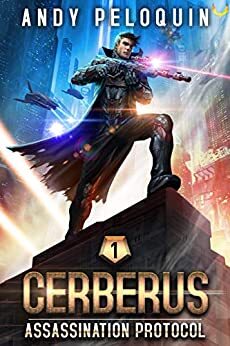 Assassination Protocol is about a crippled former Space Marine named Nolan Garrett. Nolan’s brother is in maximum security prison and the only way to keep him safe (and possibly free him) is to serve as an assassin for a galactic star empire. Armed with an AI and special suit of armor, Nolan is beneath suspicion but his bosses are as untrustworthy as a rattlesnake and his big heart is bound to get him in more trouble than even he can handle. I binged the entire twelve book series when I read the first book.
Assassination Protocol is about a crippled former Space Marine named Nolan Garrett. Nolan’s brother is in maximum security prison and the only way to keep him safe (and possibly free him) is to serve as an assassin for a galactic star empire. Armed with an AI and special suit of armor, Nolan is beneath suspicion but his bosses are as untrustworthy as a rattlesnake and his big heart is bound to get him in more trouble than even he can handle. I binged the entire twelve book series when I read the first book.
Nolan Garrett is Cerberus. A government assassin, tasked with fixing the galaxy’s darkest, ugliest problems.
Three thrilling novels featuring fearless heroes, non-stop futuristic action, and neck-breaking plot twists.
Armed with cutting-edge weapons and an AI-run cybernetic suit that controls his paralyzed legs, he is the fist in the shadows, the dagger to the heart of the Nyzarian Empire’s enemies.
Then, he found Bex on his doorstep….
A junkie, high on the drug he’d fought for years to avoid, and a former elite soldier like him. So he takes her in to help her get clean – Silverguards never leave their own behind.
If only he’d known his actions would put him in the crosshairs of the most powerful cartel in New Avalon.
Facing an army of gangbangers, drug pushers, and thugs, Nolan must fight to not only carry out his mission, but to prevent the escalating violence from destroying everything he loves.
This Special Edition Omnibus contains the first three books in the thrilling Cerberus military space opera series. It’s perfect for fans of JN Chaney, Jay Allan, and Rick Partlow. Grab your copy today!
Bonus RecommendationBecause it’s my list, here’s an 11th recommendation because why not?
Against All Odds (Grimm’s War #1) by Jeffrey Haskell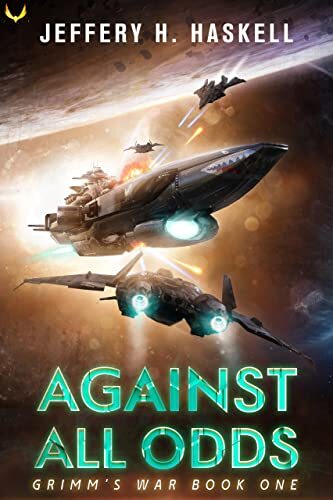 Jacob Grimm thought he was going to be a hero when he managed to wipe out an entire flotilla of enemy starships engaged in a sneak attack. However, it turned out some of those ships contained cargoes of children. Exiled to the rear-end of space, he unwittingly becomes a pawn in an attempt to rebuild the gutted Navy. But is he going to do too good of a job in his new assignment? What if he has a chance to make right his awful mistake? Can he?
Jacob Grimm thought he was going to be a hero when he managed to wipe out an entire flotilla of enemy starships engaged in a sneak attack. However, it turned out some of those ships contained cargoes of children. Exiled to the rear-end of space, he unwittingly becomes a pawn in an attempt to rebuild the gutted Navy. But is he going to do too good of a job in his new assignment? What if he has a chance to make right his awful mistake? Can he?
What is it About?
Wrong crew. Wrong ship. Right captain.
Idealistic navy Lieutenant Jacob Grimm just wanted to honor his mother’s sacrifice in the last great war. When he’s forced to return fire and destroy a squadron of ships to save his own, he thinks he’s the hero….
Until they discover the ships are full of children.
Disgraced and denied promotion, Jacob’s career is over. That is until the head of ONI needs a disposable officer to command a battered destroyer on the rim.
There’s just one problem: Interceptor hasn’t had a CO in months, and the ship is a mess. Worse, the system he’s assigned to is corrupt and on the verge of all-out civil war with the Alliance.
However, no one told Jacob he was disposable.
Pirates, smugglers, and Caliphate spies complicate the situation, and one captain with an old ship can’t enforce the law, let alone stop anyone.
The single greatest discovery of all time is about to change intergalactic politics forever. If Jacob doesn’t find a way to succeed, then it won’t just be the end of the Alliance, it will be the end of freedom for humanity.
The post Indie Military Science Fiction and Space Opera books – Part 1 appeared first on BEFOREWEGOBLOG.
May 12, 2022
Review – The Last Prince by E.G. Radcliff
A Kindle Book Award Semi-Finalist in 2021, The Last Prince by E.G. Radcliff, is Book Two in the author’s The Coming of Áed Series, but is a prequel, rather than a sequel, to the outstanding The Hidden King, which was the first book in the series.
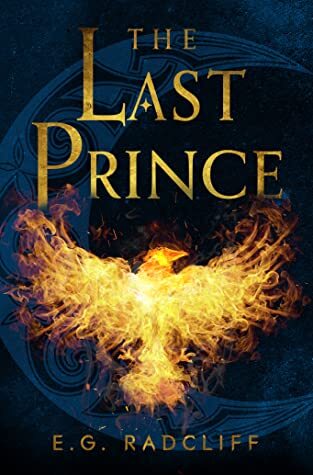 At first, I candidly admit that I found it a curious choice to write the follow-up book in a series about the events that took place before the first book. Moreover, I was concerned that, knowing the fate of Ninian and Áed’s relationship, I would not be as invested in reading about prior happenings.
At first, I candidly admit that I found it a curious choice to write the follow-up book in a series about the events that took place before the first book. Moreover, I was concerned that, knowing the fate of Ninian and Áed’s relationship, I would not be as invested in reading about prior happenings.
Wow, was I mistaken! This poignant, heart-wrenching, beautiful book greatly moved me, and now I can’t envision reading this series any other way, then having the second book as a prequel.
The Last Prince truly is Ninian’s story. We see him alone, a young boy, an orphan, and a vagrant, barely scraping by on the streets of the Maze, which is the seedy, depressing, labyrinthine slum-like residential area that readers were first introduced to in The Hidden King. Ninian is starving, stealing to survive.
Máel Máedóc is a store owner, whom Ninian steals from. Caught by Máel Máedóc, Ninian is in the gruff but secretly tender-hearted store owner’s debt. Feeling compelled to earn back the money equaling the value of the stolen food, Ninian meets a woman, Laoise, who displays unusual kindness towards him, in a place where the denizens are frequently without mercy or compassion.
But kindness on the streets of the Maze typically comes with a price. In this case, Laoise, after seeing Ninian defend himself well in a brawl, “sells” Ninian’s fighting services to a dangerous street gang.
Trapped in the vicious gang, with no seeming way out other than death, Ninian, who learned his fighting craft from his deceased mother, earns credibility and worthiness to the gang as a fearsome fighter and enforcer. Though, after a horrific incident, the noble Ninian vows not to kill any of the gang’s enemies, only injure them.
In time, working to pay of his debt to Máel Máedóc, Ninian meets Áed, a wounded and seemingly mute boy, whom Máel Máedóc rescues and fosters. What initially begins as Áed fearing Ninian, and Ninian desperate to protect and help Áed recover, turns into a deep friendship, and years later, an abiding love.
But the constant danger of Ninian’s life with the gang, and a secret that Ninian uncovers about Áed’s heritage, threaten to rip the two damaged lovers apart forever.
This slow-burn, character-driven novel, touched my soul. It would take a very cold heart not to be warmed by the beauty of Ninian and Áed’s love for one another. With this installment, we learn much more about the backstory of Ninian in particular. The loss, tragedy, abuse, and despair that both Ninian and Áed come from, only to find comfort and security in each other, greatly accentuates the pathos for those who have read “The Hidden King”. Because we the reader knows what awaits them.
While the courage and humanity of Ninian and Áed shine through their pain, trauma, and capacity to still trust, and love, the complex secondary characters are mostly decidedly unlikable. Still, they evoke empathy, and are very realistically drawn by the author. For the most part, they are products of the soul-crushing existence that the downtrodden must eke out in the Maze. Either take advantage of, and hurt others, or hurt or be taken advantage of, is the Maze’s code.
Though the tougher themes in the novel, including abject poverty and misery, brutality, torture, and sexual abuse, are extremely sensitively and properly handled, it does not mean it won’t be hard to read.
I was heartbroken by what Ninian and Áed endured, and what Ninian felt forced to do to others, in the book. Still, seeing the two lovers find each other was wonderful, even if we know it will be only temporary happiness. My recommendation, don’t read this book without a tissue box handy.
As with the previous book, Radcliff’s prose is delightful. Her stellar writing style is very eloquent, but simultaneously simple. At around 325 pages, this book can be read quickly, but one will want to take sufficient time to absorb Radcliff’s lovely writing.
“Ninian stepped into the sanctuary more fully, brushing his palms over the tips of tall grasses. The air smelled earthy and living, and though the plants looked a little scrawny, there were a lot of them. A woody vine crawled over a windowsill, playing hose to a line of ants; yellow flowers on spindly stalks swayed in the breeze. Low to the ground, bluebells carpeted every patch of earth not covered by cobblestones or grass.”
Radcliff really earns her stars in this five-star read, a tale of struggle, survival, and love that is emotional, haunting, and ultimately unforgettable. I have The Wild Court, Book Three, and the finale in the series, already on my shelves. Rest assured I will definitely be completing my reading of this wonderful series.
Check Out The Last PrinceThe post Review – The Last Prince by E.G. Radcliff appeared first on BEFOREWEGOBLOG.
Interview with David Towsey, Author of Equinox
David Towsey is the author of the upcoming Equinox novel, The Walkin’ trilogy, and one-half of the creative partnership of D.K. Fields. Equinox, David’s newest release takes place in a world where every human body contains two distinct identities – a day brother and a night brother. One never sees the light, the other nothing of night.
David sat down with GDM to discuss his writing, computer games, the nature of binaries, and his love of ice cream. Thank you for sitting down with us and having a chat.
[BWG:] In case people are not familiar with your work, could you tell us about yourself?

Sure thing. I write novels, short stories, and indie computer games – mostly in the SFF genre. I guess I blend a lot of genre elements in what I do; my first novels apparently cornered the market on literary zombie-westerns. My next release, Equinox, is a mix of dark fantasy, folk horror, and witch-hunts with a strong SF-style “what if?” at its core. Game-wise I’m one half of Pill Bug Interactive, and we’ve released three gam so far across Steam and Nintendo Switch . I’ve also co-written a fantasy-crime trilogy under the pseudonym D.K. Fields. I think it’s fair to say I like to mix things up.
. I’ve also co-written a fantasy-crime trilogy under the pseudonym D.K. Fields. I think it’s fair to say I like to mix things up.
[BWG:] I read that you are an ice cream man, is that still the case?
Ice cream is not just a dessert, it’s a mindset. Especially once you accept pistachio flavoured ice cream into your life.
[BWG:] I read that you enjoy computer games and MMOs and that you play Magic: the Gathering at a competitive level. As a game geek myself, I would love to hear more about that.
Oh wow, you have done your research! I actually stopped playing MMOs a few years back, around the release of WoW’s Mists of Pandaria. I still have a lot of love and respect for that form of gaming, but I just couldn’t give it the time and dedication I wanted to. I’ve also hung up my Magic slinging boots (not sure that metaphor works, but I’ll run with it). When my partner and I moved to Cardiff in 2016 we got involved in the local board gaming scene. We met loads of lovely people, played so many great games, that I didn’t find myself driven to keep up with Magic.
But when the pandemic hit, like many folks my work went solely online so I was in front of the screen even more than usual. I picked up an old, old hobby of mine in miniature painting. Mostly Games Workshop, but some 3D printed stuff to. It was a lot of fun getting back into that and seeing how far the hobby had come since I was a kid (YouTube painting videos are amazing!) That inevitably led to playing miniature games, and I’ve just started to get into tournaments for Age of Sigmar… once a tournament gamer, always a tournament gamer, I guess.
[BWG:] I read an interview you did where you were asked about your introduction to genre fiction being The Hobbit. I think many of us had similar experiences. Are there any other books out there that had profound influences on you as a reader?
So many, it’s hard to narrow it down. Perhaps one of the biggest influences for me as a reader and a writer would be Richard Matheson’s I Am Legend. I love so much of his work, but this book in particular opened my eyes to a certain kind of horror writing. For many readers in the 1950s and 60s, he brought horror to the suburbs and showed it could exist outside places like Dracula’s castle. Even decades later, as a young reader I experienced that powerful effect which brought horror home, and it stayed with me. I don’t necessarily write horror in the purest sense (though, I suppose that’s open to debate). But I think my interest in the genre is firmly rooted in the family and domestic spaces.
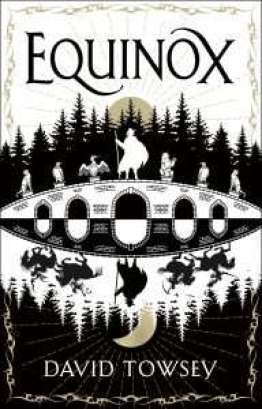 [BWG:] As one half of the Pillbug Interactive duo, you’ve written for games such as Make It Home, Cycle28, and Intelligent Design. What would you say the difference is between writing a great book and writing a great game? Do you have any techniques that only work for one or the other? Is there anything that surprised you by working well in both media?
[BWG:] As one half of the Pillbug Interactive duo, you’ve written for games such as Make It Home, Cycle28, and Intelligent Design. What would you say the difference is between writing a great book and writing a great game? Do you have any techniques that only work for one or the other? Is there anything that surprised you by working well in both media?
I think it’s really important to respect each form of writing on its own terms, even though there are often crossovers. It’s dangerous to assume because you can write in one medium, it’s going to be easy to write in another. So, I went into games knowing I had a lot to learn, and as open-minded as possible. One of the most obvious differences between books and games is that for most games “writing” is only part of how a story is told. There are so many other factors: visual story-cues, game play mechanics, user interfaces, sound effects and music – the list goes on. This can be quite a shock for a fiction writer who is used to having almost complete control over their story. It can feel like a steep learning curve. But the good news is: some skills do translate. I’m quite a dialogue-heavy writer, and this helped a lot with writing for games; more often than not you’ll be writing dialogue, rather than full scenes or description. If you can craft an economic conversation that covers some key story beats, without it feeling too wooden or forced, that’s a great start for game-writing.
[BWG:] Could you tell us a bit about the Bath Spa Creative Writing Masters program?
In short: I had a blast on my MA. I was one of the youngest of the cohort, coming almost directly from my BA in Creative Writing at Aberystwyth, and it was brilliant to be around such a diverse group of driven writers. There was a huge variety of projects people were working on – in prose, poetry, and other mediums. It was a really good energy to be immersed in for someone trying to write their first novel. I started Your Brother’s Blood on that course, and have a lot of people to thank for how it turned out (don’t worry, they all appear in the acknowledgements).
[BWG:] How has the program helped you as a writer?
I’m sure their website would tell you the particulars, but my experience of the program was of learning a lot about writing in a very intense year. I’d already started to grasp how scenes were constructed, how and when to be economic with language, and how important voice was to a story; but it wasn’t until my MA that I felt confident in applying these ideas to my own novel-length project.
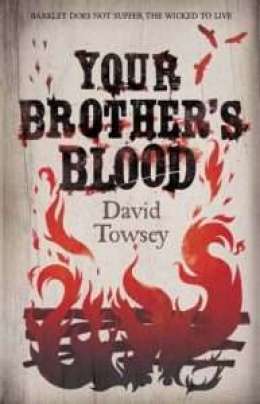 [BWG:] You have a Ph.D. in creative writing, what was your dissertation on?
[BWG:] You have a Ph.D. in creative writing, what was your dissertation on?
The critical element of my thesis explored representations of absent parents in SF novels. In one chapter I did a close reading of Matheson’s I Am Legend through the lens of Attachment Theory – as I mentioned earlier, it’s a novel that had a big impact on me as a reader. The creative element of my Ph.D. was a novel called The Orbital Son. The theme of absent parents in the critical thesis carried over to the novel, which follows a young man as he tries to reconnect with his dying father. It’s not the most subtle thing I’ve ever written, but I learned a lot writing it.
[GdM:] What was your experience with language and writing where you discovered just how powerful it can be?
As a reader, I’d say it was reading The Hobbit as a kid, which you mentioned earlier. I was on a holiday, stuck in a car with my grandparents for hours on end. I was amazed that words on the page could take me away from that hot, stuffy car and put me in a totally different world. As a writer, I didn’t have much confidence in my own ability to do that until readers started commenting on the particulars of Walkin’ characters, as if they were real people. I’d managed to use language to get readers to think about living on after death, about poking your own spleen through a hole in your chest, and how a father might convey this all to his daughter. That felt pretty powerful.
[BWG:] When you are writing a story do you start with an idea, such as “what it would be like to live forever” for example in Your Brother’s Blood? Or do you start with a character such as Christopher Morden from Equinox and go from there?
I’m definitely an ideas-led writer. I start with a concept that might make for an intriguing set-up, and then start exploring what stories feel like a good fit for it. With the Walkin’ Trilogy that was, as you say, about how the burden of living forever might affect a family. In a sense, it’s a kind of family saga told over three books rather than one big one. For Equinox, the two-people in each body concept changes so much, I could have told a thousand different stories. But it led me down some pretty dark paths from the get-go. The idea of one half of a witchfinder falling in love with a suspect, while the other half tries to convict them really appealed as a way to link concept and story.
[BWG:] The Walkin’ Trilogy is a zombie-western and has a very different feel, it is much sparser in prose, then Equinox. Was that a conscious choice or was that how the writing evolved organically?
It wasn’t a conscious choice to make that change. The voice of both books was led by their respective worlds. We talk a lot as SFF writers about worldbuilding, but it’s a conversation often dominated by things like social or power structures, magic systems, that kind of thing. Not so much about voice or tone. When I write, I want my prose to feel part of that world. Sparse, staccato prose for the Walkin’ Trilogy’s western landscape sounded right to me. Equinox is looser, and maybe denser, to reflect the thick forests surrounding Drekenford – and the slightly claustrophobic nature of that village.
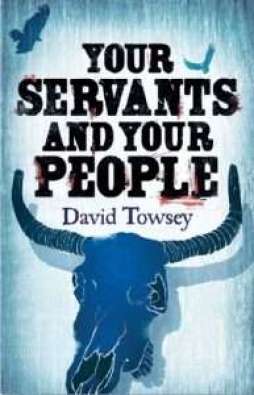 [BWG:] How do you feel about SFF as a genre in 2022? Where do you see the genre branching off to in the future?
[BWG:] How do you feel about SFF as a genre in 2022? Where do you see the genre branching off to in the future?
I think SFF is in a positive place right now. It’s such a broad genre, or group of genres, that there’s work being published for a wide range of readerships and tastes. The diversity of voices is improving, but it’s fair to say there’s still a way to go on that front. I hope that more writers and readers coming to SFF will branch the genre in ways that I can’t even imagine – which is the whole point, isn’t it? It’s a playground for sharing our individual, esoteric imaginings of the future.
[BWG:] You write as one half of the creative partnership D. K. Fields with poet Katherine Stansfield. How does your partnership work? Do you jointly talk about every aspect of the story, or do you take chunks of things then combine them?
It was messy. At least, it started that way. Neither Katherine nor I had co-written anything before. When we started Widow’s Welcome – the first book in the Tales of Fenest Trilogy – we took an admirable, yet naïve, set of decisions to make the process as democratic as possible. We each wrote a chapter of the same story, passing the manuscript back and forth. When we had a full draft, we even line edited together in a Google.doc, facing each other at the same table on two laptops. Many arguments ensued about commas and the like. By the time the trilogy was finished, we’d worked out a smoother but still equal process… and we haven’t written together since.
[BWG:] Could you tell us about your upcoming release, Equinox?
It’s a dark fantasy story about a witchfinder, Special Inspector Christophor Morden, who is sent to a remote village to hunt a witch. A man has clawed out his own eyes, driven to do so by teeth growing in his eye sockets, and sorcery is the suspected cause. But in this world every physical body has two people inside it: one day-sibling, one night-sibling. So, Christophor’s day-brother, Alexsander, has no choice but to accompany him on this witch-hunt. As the investigation leads one brother closer to his witch, the other finds himself falling in love with a prime suspect.
[BWG:] How did you come up with the idea of a day sibling and night sibling?
In a strange way, I have Katherine to thank for the initial spark for this idea. She was taking a nap one day in a chair near a window and her face was almost perfectly half in shadow, half in the light. Seeing this happened to coincide with some things I was working through personally about why we’re strong in some ways and vulnerable in others. The image of her face “split” by light and shadow crystalised this duality in that moment, and I found myself imagining how I might push it to an extreme. Two different people in one body, each strong in some ways but vulnerable in others, seemed like an interesting concept to explore.
[BWG:] Is it fair to say that the concept of binaries is an important part of Equinox? I appreciated that in the story people are more complicated than “good/bad” or “black/white” but that they are shades of gray.
I think the core binary of night-day sibling is essential to Equinox. But I wanted to explore the very idea of binaries in the book. I liked the irony of a novel that presented as black-and-white (and Head of Zeus did a wonderful job on the cover in this regard) but was actually a story about the complications and nuances that are part of any binary, if you just scratch the surface. It’s not a new idea, and many better writers than I have examined this in far more significant contexts. The most I can hope for is that Equinox gets one or two readers thinking about the nature of binaries.
[BWG:] I hear that you write to music. How do you pick the music for the novel, does the playlist go along as things change? What was the playlist for Equinox?
I do indeed write to music. I construct a playlist for each project, with songs taken from a fairly wide variety of artists. The emphasis is, again, on tone. What kind of mood do I want to put myself in while writing? Sounds obvious, but like a lot of people music has a huge impact on how I feel in any given moment. The playlist for Equinox was pretty bleak. Songs from artists like Mazzy Star, Alice in Chains, and Elliot Smith featured heavily. But even more “upbeat” artists have songs that felt right for some of the darker elements of Equinox – bands like The Mars Volta, Fleetwood Mac (of course, Rhiannon had to feature), and Coheed and Cambria. It’s all stuff I’d listen to anyway, but brought together to set the tone in the background as I write.
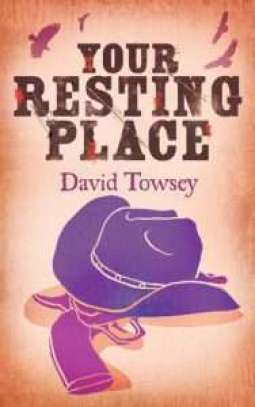 [BWG:] You released Your Brother’s Blood in 2013, the first novel of The Walkin’ Trilogy. What lessons have you learned since then regarding your writing workflow? Was Equinox easier to write than Your Brother’s Blood?
[BWG:] You released Your Brother’s Blood in 2013, the first novel of The Walkin’ Trilogy. What lessons have you learned since then regarding your writing workflow? Was Equinox easier to write than Your Brother’s Blood?
I wish! Equinox was perhaps the most challenging book I’ve ever written – and that includes learning to co-write. The technical issues caused by having two personalities for every character when trying to plot a kind of crime investigation… do you know that Charlie Day conspiracy board meme? It became a kind of totem animal when drafting Equinox. I very nearly lost it on that book. That said, perhaps the biggest lesson I’ve learned since 2013 is that I revel in the challenge. If writing feels easy, I don’t trust it. I have keep pushing myself, like a shark has to keep swimming, otherwise, I’m sunk.
[BWG:] What things do you have coming up?
Well, the release of Equinox is keeping me pretty busy at the moment. But the next novel project is in the research and planning stages, so that’s starting to feel exciting. I can’t say too much yet, only that it will be another blend of fantasy and horror that puts some fairly unusual elements together. Pill Bug Interactive is similarly in the early stages of our next game. And who knows, maybe D.K. Fields will “get the band back together” for another series. It’s an energising time, full of creative possibilities.
Interview originally appeared on Grimdark Magazine
Check Out Equinox by David Towsey
The post Interview with David Towsey, Author of Equinox appeared first on BEFOREWEGOBLOG.
May 11, 2022
A Revisit to My Old Self – A Review of The Beach by Alex Garland
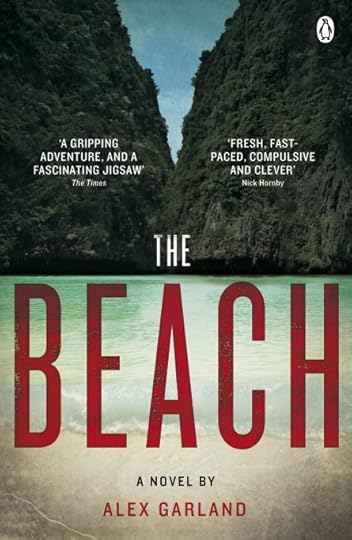 Have you ever looked back at something you read 15 or 20 years ago and had that “A-Ha” moment? The mind-altering epiphanic moment when you realize that a plot point salient to the whole freaking novel zoomed right the hell over your head. I had one of those recently when it came to Alex Garland’s novel, The Beach.
Have you ever looked back at something you read 15 or 20 years ago and had that “A-Ha” moment? The mind-altering epiphanic moment when you realize that a plot point salient to the whole freaking novel zoomed right the hell over your head. I had one of those recently when it came to Alex Garland’s novel, The Beach.
My gorgeous and bright novel, The Beach, was not about the things I thought it was as an impressionable 20-year-old. Quite the opposite, really. I thought it was about the glories of travel and hedonism. Instead, I now know that it was about how utopia is overrated, and the beautiful and shiny might be rotting inside. That Richard was a beautiful, unique butterfly, just like all the rest of the unique and beautiful butterflies doing the same thing. Richard was a child, instead of the wild king I had remembered him being.
I did not learn any of this till I reread the book 20 years later. What a difference twenty years makes.
On the one hand, I felt foolish, looking back on my younger self through the lens of 20 years of growth and wisdom. To my credit, while I did have an astonishing naivete to many things in life, I recognized the most important thing about the book, and it is this. Under the glossy covers, the terrible movie and the fantastic music was an important idea. I, at a young age, just grabbed on to the wrong one.
I read this book when I was right out of high school and entirely in love with the idea of a wild wonderland—a paradise filled with gorgeous people and no responsibility. I wanted to see, do, and experience that life. I wanted to suck the marrow out and let it dribble down my chin. I still do now, older and grayer. However, those ideas are now tempered with age, trust, and hopefully, steadfastness. Wild abandonment and hedonism sound great on paper until you think about all the people you abandon. I am no longer willing to do that.
I looked up to Richard and his friends at the time; I yearned to have the same cultural experiences he had in the book. Am I strong enough to fly to Thailand alone? The bright and the dirty, the wild, and the serene. I wanted to lay on the beach, have crazy sex, drink water coming from a waterfall, and live in this idyllic commune. I wanted it all so much.
And yet, instead of traversing the world, I went to college. Lived at home, dated the same man for years, and lived a quiet life. I resented that life, but at the same time, I felt like I was achieving something. And that wild hedonistic dream slowly started to slip away to be replaced with different dreams.
The problem was that when I reread the novel instead of the inspiration, I was left unsettled and feeling dirty. It felt like someone had taken my brain and used it to scour pans for an afternoon. The book was like a beautiful Honey Crisp apple sitting on a shelf, but it is full of maggots when you cut into it. The novel’s plot is “After discovering a seemingly Edenic paradise on an island in a Thai national park, Richard soon finds that since civilized behavior tends to dissolve without external restraints, the utopia is hard to maintain. ” Richard, the main protagonist of the story, lives a very plus lifestyle at home, enough that he can set out to travel the world, mostly alone.
Richard ends up in Thailand, where he meets a young french couple. Richard experienced something he didn’t have much experience with, jealousy. He wanted her. They hear a rumor and see a map to a hidden paradise. Honest to God untouched paradise unsullied by tourism. They take a boat out, follow the island’s plan, pass some through fields of marijuana, and come to a waterfall.
They jump, and because they jumped, they are introduced to a community of people just like them.
That community is idyllic on the outside, but a scene that I thought was just sad then is horrifying to me now. A group of Swedes who are part of the community surf in the lagoon while the tide is low. They know that sharks come into the cove at this time to fish, but it is so beautiful the surfing couldn’t be missed. The sharks promptly murder and eat a few group members while leaving one with just his leg hacked off.
The commune has a choice, take the man back to safety via boat and not be allowed to come back to the idyllic island and then the man will probably live. Or leave the man on the beach on a comfy blanket and hope for the best. And, in best, they mean to let him bleed to death. In their minds, they are sacrificing the individual for the good of all. I see this often in novels and later in life, which is terrifying. Covid has shown the true colors of many people.
“Trust me, it’s paradise. This is where the hungry come to feed. For mine is the generation that travels the globe and searches for something we haven’t tried before. So never refuse an invitation, never resist the unfamiliar, never fail to be polite & never outstay the welcome. Just keep your mind open and suck in the experience— And if it hurts, you know what? It’s probably worth it.”
― Alex Garland, The Beach
It had not lived up to my fantasies. I felt cheated and weak. What was weak was my perspective and understanding of life beyond my hometown at the time. “The Beach” has nothing to do with paradise, but the outlook on what constitutes a paradise, the darkness in people, and the lengths to which one would go to protect it. It is a smart book and subtle in its narration. Its overall gravitas was not something I could appreciate at the time, but it is something that I can look back on now and understand.
One of Garland’s subtler things and I noticed on rereading it, is that Garland keeps the travelers’ everyday life very mundane. He describes the day-to-day tasks that they need to accomplish; Fishing, farming, and partying. At the time, all I read was background noise. However, I see this as how each of the character’s reactions to the mundane subtly hints at the darker parts of the characters’ psyches. It reminds me of a much less ham-fisted and more eloquent lord of the Flies, but for a more modern audience. In the end, the characters are scarred both mentally and physically.
“The first I heard of the beach was in Bangkok, on the Ko Sanh Road.” ― Alex Garland, The Beach
If you are looking for a book that tears you up inside a bit, look no further. It is worth the second read, especially if you have some life experiences behind you.
Read The Beach by Alex Garland
The post A Revisit to My Old Self – A Review of The Beach by Alex Garland appeared first on BEFOREWEGOBLOG.
Review – Kill The Dead by Richard Kadrey
― Richard Kadrey, Kill the Dead
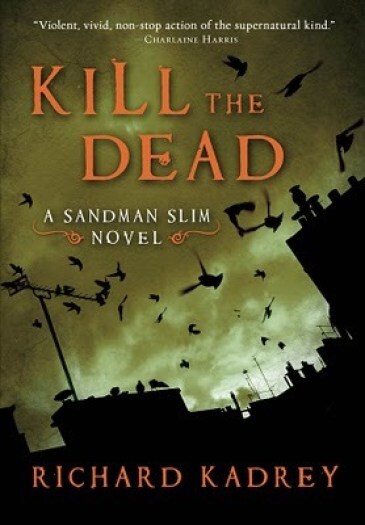
From the publisher, “What do you do after you’ve crawled out of Hell to wreak bloody revenge? If you’re Stark you turn to bounty hunting, tracking and decimating whatever rogue monsters you’re paid to kill. Stark hates the work, but he needs the money, especially the big bucks Lucifer is offering. In town as an adviser on a biopic of his life, Lucifer needs protection, and he wants Stark as his bodyguard. But the gig isn’t all bad; there is the very sexy, very hot French porn star Brigitte Bardo, a friend of Lucifer’s in LA to remake her reputation as a legit actress. While it isn’t love, it’s pretty damn good, and after 11 years of demonic chastity, it’s enough for now.
Stark has enough trouble juggling a diva devil and a scorching French bombshell without a zombie plague to complicate matters. And just what happens when a human-angel half-breed is bitten by the living dead? His human side begins to die, transforming him into an unstoppable angel of death—a killing machine devoid of emotion or thought, with no regrets or future to worry about. Not a bad way to be when your choices are limited. Now, Stark has to decide . . . if he does find a cure for the zombie infection, will he take it?”
My Thoughts“Hell is hilarious if you’re the one in charge.” ~ Lucifer
I absolutely love this series thus far. I read the first “Sandman Slim” book, aptly named just “Sandman Slim” and dudddde, holy anti-hero batman. Yaas. Bring on the “I don’t give a shit attitude.” I love that the language in Sandman Slim is punchy. Not overly wordy and detailed. I want some concisely written words.
I received everything I asked for and more from reading #2 in the series. Sandman Slim should be on more lists and garner more praise. It should be up there with the likes of Dresden, and October Daye; it is just that damn good. It is refreshing when there seems to be so much unoriginal urban fantasy. Always the same sort of schtick. Not this book…
“Twenty percent? What am I, your waiter? I got you five vampires, not a BLT.”
― Richard Kadrey, Kill the Dead
This story picks up a while after the first Sandman Slim story left off. We have our resident anti-hero having a hell of a time mentally, and in some ways physically while he tries to pay the bills by doing the odd killing or menacing here and there. I don’t want to give too much away, but if you enjoyed the first book in this series, “Sandman Slim” you will probably enjoy this one. They are a little different in style and texture. But, the dark humor and great story come through. There is a bit of a love interest, and a new interesting character getting fleshed out in Lucifer. I am going to keep this short, as this book is a pause in a longer story. But read the series. It is so worth it.
First Chapter, First Paragraph – The Everything Box by Richard Kadrey
Check Out Kill The Dead
The post Review – Kill The Dead by Richard Kadrey appeared first on BEFOREWEGOBLOG.
May 10, 2022
Review – This Thing of Darkness by Allan Batchelder
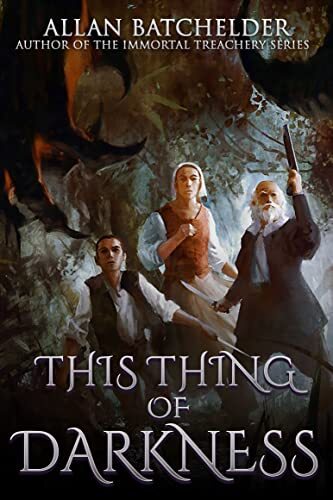 THIS THING OF DARKNESS by Allan Batchelder is a high concept novel if I’ve ever heard one: What if William Shakespeare faked his death and tried to make a new life in Jamestown? It’s an interesting promise that I am arguably spoiling a bit of a reveal but is the chief reason to pick up this fascinating novel. Its title and events certainly give this the appearance of a horror novel but it also works very well as a character study. I am happy to recommend it without further bringing any elements of its plot in on the basis of its research and authenticity of human feeling. Which is not something I normally say about a monster stalking a bunch of English settlers.
THIS THING OF DARKNESS by Allan Batchelder is a high concept novel if I’ve ever heard one: What if William Shakespeare faked his death and tried to make a new life in Jamestown? It’s an interesting promise that I am arguably spoiling a bit of a reveal but is the chief reason to pick up this fascinating novel. Its title and events certainly give this the appearance of a horror novel but it also works very well as a character study. I am happy to recommend it without further bringing any elements of its plot in on the basis of its research and authenticity of human feeling. Which is not something I normally say about a monster stalking a bunch of English settlers.
The premise, as quirky as it may be, is something that is grounded by “William Kemp” whose true identity is something that the story eases into but leaves plenty of clues to from the beginning. William has his reasons for wanting to fake his death and flee England that we gradually discover through the judicious use of flashbacks but the point is that he is not someone who easily fits into the ranks of the new colony.
Partially due to the reasons that he fled, partially due to his high intellect, his irreligiosity (mostly expressed in a lack of interest in regular churchgoing–a horrible offense then), and his fear of being discovered, he lives at the edge of the community. He makes association with other outcasts, though, and forms his own little community that leaves him content for a time.
There is something out there in the woods, though, and William’s imagination draws parallels between Grendel and his own Caliban, especially when signs that it’s a kind of cannibalistic monster. Is it a werewolf, 16th century serial killer, troll, or something wholly new? The locals, as you can imagine, are quick to blame the local Powhatan. Even William is skeptical of his own mind at work when he notes that a perhaps more likely explanation is some of the released criminals at work in the colony combined with the victims’ bodies being feasted on by animals postmortem.
If I were to make an odd comparison, this reminds me a bit of the John Cussack Edgar Allan Poe movie, The Raven, except much better. That movie suffered from making its titular celebrity the center of the murders as well as forced into their investigation. Here William is a reluctant detective and doesn’t have any skill at it but is moved by the fact it personally threatens him as well as those people he cares about. I appreciate all the effort Allan Batchelder takes to humanizing the Bard with his regrets over his failed marriage, relationship with a prostitute named Luca, and the jokes of plagiarism made about him.
This is the rare book I state is just extremely good from start to finish and is one that benefits extremely from its prose. While not William Shakespeare himself, he manages to create a believable enough man that could theoretically come up with England’s greatest plays. A somewhat roguish man but never so much as to be unbelievable for the time period. A somewhat darker and more morose version of SHAKESPEARE IN LOVE’s take on the Bard perhaps. The supporting cast is solid too and I cared enough about them to want to see whether they became monster chow.
Highly recommended.
5/5
Check Out This Thing of DarknessThe post Review – This Thing of Darkness by Allan Batchelder appeared first on BEFOREWEGOBLOG.
Review – The Roach by Rhett C. Bruno
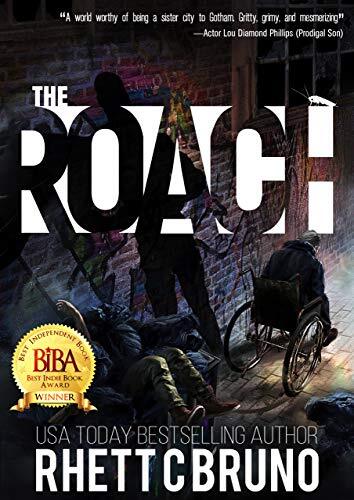 THE ROACH by Rhett C. Bruno is a deconstructionist superhero tale in the vein of Watchmen. One of the things that Alan Moore suggested in said work as, and this is a shocking idea, that people who decide to beat up criminals in a costume are probably not mentally sound. The Roach is something of a combination of Batman, the Punisher, and Rorshach with more of the latter than the former.
THE ROACH by Rhett C. Bruno is a deconstructionist superhero tale in the vein of Watchmen. One of the things that Alan Moore suggested in said work as, and this is a shocking idea, that people who decide to beat up criminals in a costume are probably not mentally sound. The Roach is something of a combination of Batman, the Punisher, and Rorshach with more of the latter than the former.
Reese Roberts is no longer the Roach, though, because he’s been crippled in the line of duty. A gunshot injury has left him confined to a wheelchair and with nothing but regret as well as simmering anger to keep him going. He has a single friend in the young woman he saved from her rapist and almost no one else. Reese is suicidal because of his status but he wasn’t in a healthy mental place to begin with and the fact he’s considered a serial killer isn’t something that’s easy to argue against.
This isn’t a happy story. This ostensibly takes place in the “real world” or something significantly more grounded than your average comic book world. There’s no magical therapy or cure for Reese’s condition and he’s never going to get out of the chair. He also is a thoroughly detestable person if you don’t have values that believe all criminals are pure evil and deserve to die. However, it’s never BORING to be inside Reese Roberts’ mind and that is the best thing to say about any book. The plotline is about all the Roach’s sins coming back to haunt him and dealing with the final mission that got him crippled. I felt there were perhaps a few too many coincidences but compared to your average comic book, it’s the height of plausibility. We also have a lot of memorable characters as the Roach touches multiple lives for both good and bad.
As a writer of superhero fiction, myself, it’s a rare story that I would say is a “hard R-rated noir detective thriller” but this certainly qualifies. It touches many ugly places, and the protagonist is not someone that the author hesitates to make unlikable. He is an awful person and quite possibly ill but he’s also very charismatic as well as someone that I wanted to know the next move of.
Rhett C. Bruno has an extremely engaging style that sucks you right in and I totally believed in his fictional city of Iron Heights. I will state that readers should be warned this book contains such triggering subjects as suicide, rape (offscreen), child abuse, and graphic violence. It is grimdark as all get out.
Check out The RoachThe post Review – The Roach by Rhett C. Bruno appeared first on BEFOREWEGOBLOG.
May 9, 2022
Review – Space Academy Dropouts by CT. Phipps and Michael Suttkus
“Boldly going because they’re completely lost.”
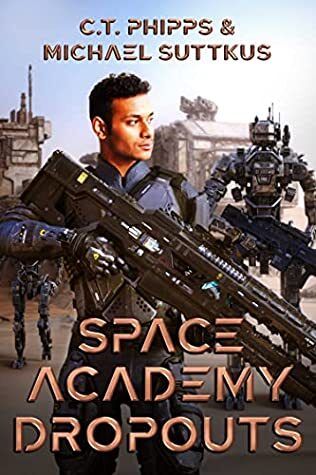 What is Space academy Dropouts About?
What is Space academy Dropouts About?The newly renamed Vance Turbo has sabotaged his own career at Space Fleet Academy due to a desire to atone for training accident. Unfortunately, his actions result in him getting press-ganged into an expendable crew of misfits recruited by a legendary starship captain. Their mission? To recover a collection of lost sun-destroying missiles that could restart a galactic war. Unfortunately, Vance is smart enough to know something is wrong with this picture. After all, no sane person would recruit this crew to save the universe.
SPACE ACADEMY DROPOUTS is an all-new series from the hilarious duo of C.T. Phipps (Supervillainy Saga, Agent G) and Michael Suttkus (I Was a Teenage Weredeer, Lucifer’s Star) that lampoons the space opera as well as military science fiction genres.
ReviewAny time I get a chance to review a new book by C.T. Phipps and Michael Suttkus, I’m more than happy to jump on it. I’ve read all their other books, and have come to expect some seriously funny characters, fast paced plots and pop culture nods throughout. Space Academy Dropouts has all the things I’ve come to expect and more besides. They have even managed to tie it into their various other series in interesting ways, adding more flavor to their comedic multiverse.
The world building is what I’ve come to expect from these authors. Using a mix of futuristic sci-fi with nods to current time, it’s a world of space ships, wormholes and cyborgs, mixing in microwave popcorn and Star Trek references. This is tied most closely to the author’s Agent G and Lucifer’s Star universes, set in between the two timelines. The world is going through the initial changes in the decades after first contact with The Community, the broader galactic civilization of aliens. We get a good look at the early version of some settings in Lucifer’s Star, and even meet an ancestor of one of the main characters from that series. We also get a sneak peek at how that timeline’s conflicts originated, in some really surprising ways. It’s a very effective tie-in to the timelines I mentioned.
The characters are the usual eclectic bunch of misfits you’d expect from these authors. the main protagonist, Vance Turbo, bears a striking resemblance to a certain young starship captain named James T. Kirk, although he’s nowhere near as dedicated and responsible. In fact, he’s what would happen if you mixed Kirk with Han Solo, with some typically hilarious results. He is actually very competent, but certainly doesn’t want to live up or down to various family legacies.
Vance’s crew is also hilarious, as you would expect. Whether it be an ex girlfriend who happens to be a spy, a cyborg mercenary or an AI in a biological android body, they all get some really interesting arcs to flesh their characters out. You never feel like they’re just in the book to move the plot along, but are integral to the story. The villains are fairly standard for their books, having a mix of motivations based on their culture and outlook. They all tend toward the fascistic end of motivations, which to me seems a little repetitive and is perhaps the only weakness of the book, but it’s a minor weakness, and certainly not enough to put anyone off reading the book.
The audiobook version is narrated by the talented Jeffrey Kafer. This isn’t surprising, since he narrates most of the author’s work. As always, he does a great job bringing the various characters to life, injecting the snark necessary to make the author’s vision a reality. You are never in doubt about which character is speaking, and you can’t help but become engrossed in the story. His narrative pacing is some of the best in the business, and he could make reading the phone book interesting. This is a version you should definitely consider.
If you have any interest in comedic sci fi- this is definitely a book you can get into. It’s not required to read any of their other books to understand this one, since it is separated enough in time from any of their other series to be its own timeline. It should make you more interested in checking out those other series to see how past and future events played out, though, and I think will create even more fans for those series. I heartily recommend this book, and am excited to read the next installment in the coming months.
RATING: 9/10
More About by C.T. PhippsReview – Psycho Killers In Love by C.T. Phipps
Check Out Space Academy Dropouts by CT. Phipps and Michael Suttkus
The post Review – Space Academy Dropouts by CT. Phipps and Michael Suttkus appeared first on BEFOREWEGOBLOG.
#musicmonday Gogol Bordello – Start Wearing Purple
This is one of those songs that on first listening may seem odd and silly, but I have heard this song about a 1000 times now, This is one of my husband’s favorite songs, and I totally dig it. Who would have thought of a punk mashup would be so catchy.
*header image found here
The post #musicmonday Gogol Bordello – Start Wearing Purple appeared first on BEFOREWEGOBLOG.
May 8, 2022
Review – Reborn Yesterday (Phenomenal Fate #1) by Tessa Bailey
Hello again dear reader or listener! It’s been a while huh? You might remember from my last review (Ali Hazelwood’s The Love Hypothesis which you can find here) how I decided to challenge myself to read more books that aren’t my usual genre, and that’s what I’ve been doing since February. In that time, I discovered Tessa Bailey and I’ve grown pretty fond of her romcoms, the main reason being that they don’t take themselves too seriously, while also handling important topics. Which is exactly what I’ve been needing out of my reading of late; lighthearted and fun books that give me a laugh and good feels.
 So when I saw she’s got a completed paranormal trilogy of standalones, I jumped on it. Also because the premise of three vampire roommates sounded hilarious. Three characters sharing one brain cell will never fail to make my day.
So when I saw she’s got a completed paranormal trilogy of standalones, I jumped on it. Also because the premise of three vampire roommates sounded hilarious. Three characters sharing one brain cell will never fail to make my day.
Reborn Yesterday focuses on mortician Ginny and vampire Jonas’ fateful encounter after the other two vampires prank him by sneaking Jonas into her morgue while he’s asleep.
Right from the get-go Bailey’s characters endear themselves to the reader, especially Ginny with her love of old movies and quiet life at the edge of any meaningful social interaction due to her job. Her dark humor, accidentally speaking her thoughts out loud, as well as her naiveté in the face of many things, are all brought forth very organically through Bailey’s prose, making for a truly lovable protag. Add to that a small cast of memorable side characters comprised of the other two vampire roommates, easygoing Tucker and grouchy Elias, as well as a knife-wielding Russian vampire slayer named Roksana, and you have a dysfunctional found family/ band of misfits dynamic that is endlessly amusing.
As for the overall plot, this book has your run of the mill paranormal romance tropes which while not revolutionary or necessarily new, are still enjoyable to read in much the same way as you’d settle down to rewatch your favorite old school paranormal series ala Angel or Charmed (brb feeling a sudden wave of dang, I’m old). In fact, as I said at the start, this first book doesn’t take itself too seriously, and while it does have that touch of melodrama that comes with most urban fantasy involving vampires – I say this with only mild and fond mockery, mind you – it doesn’t lean into it to an eye-rolling degree but rather lowkey makes fun of itself at the same time. You could say it finds itself on the right side of campy.
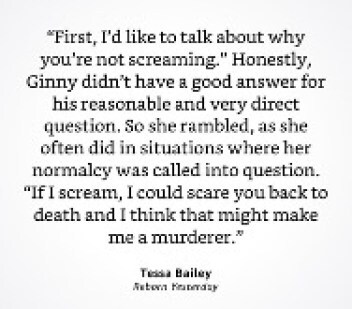
My only overall peeve with the story however is that it could have developed a couple aspects more. Firstly it was a bit too insta-lovey for my tastes. In a way, I get the reasons for it, as the main underlying trope used is Fated Mates which, upon consulting the higher authority I know on the topic (my mom, seasoned romance reader that she is), I’m told is part of the course. But still I think that this book could’ve benefitted from spending a little more time and effort on this new relationship, after all, the characters had good chemistry and getting to see more of them would’ve been a welcome thing. And secondly, the main villain fell a smidge flat by just being a token evil guy, ominously evil-ing away from his evil lair. Given that this was the author’s first foray into paranormal fantasy, and she shines more in writing interpersonal relationships though, I’m cutting her some slack. I did come into this book for the shenanigans rather than look for an epic so I won’t nitpick that one.

Although, I have a feeling that Bailey will get her chance to pick up the slack in both regards with the sequels, and I’m really eager to read more about the characters she introduces with this first book. Moreover, Bailey handles the topic of the power dynamic between the main duo quite well and doesn’t let her fragile human protag to sit back and allow herself to always be coddled and commanded by the angsty and domineering vampire, as I’ve come across in the past with similar premises. Jonas, while mostly a sweetheart, also has to learn to compromise and that is always good fun to read, especially because it makes way for amusing scenarios involving very aggravated characters.
As for some content warnings, this is an adult romance so there is explicit sexual content and, at the risk of stating the obvious, several scenarios involving blood are a given.
All in all, this may not have been a perfect novel with a complex or never before seen plot, but if taken as lightheartedly as it itself is, you have a simple story with fun and lovable characters to keep you company and distract you for an afternoon when all you need and want is to turn your brain off.
8/10
Until next time,
Eleni A. E.
The post Review – Reborn Yesterday (Phenomenal Fate #1) by Tessa Bailey appeared first on BEFOREWEGOBLOG.



